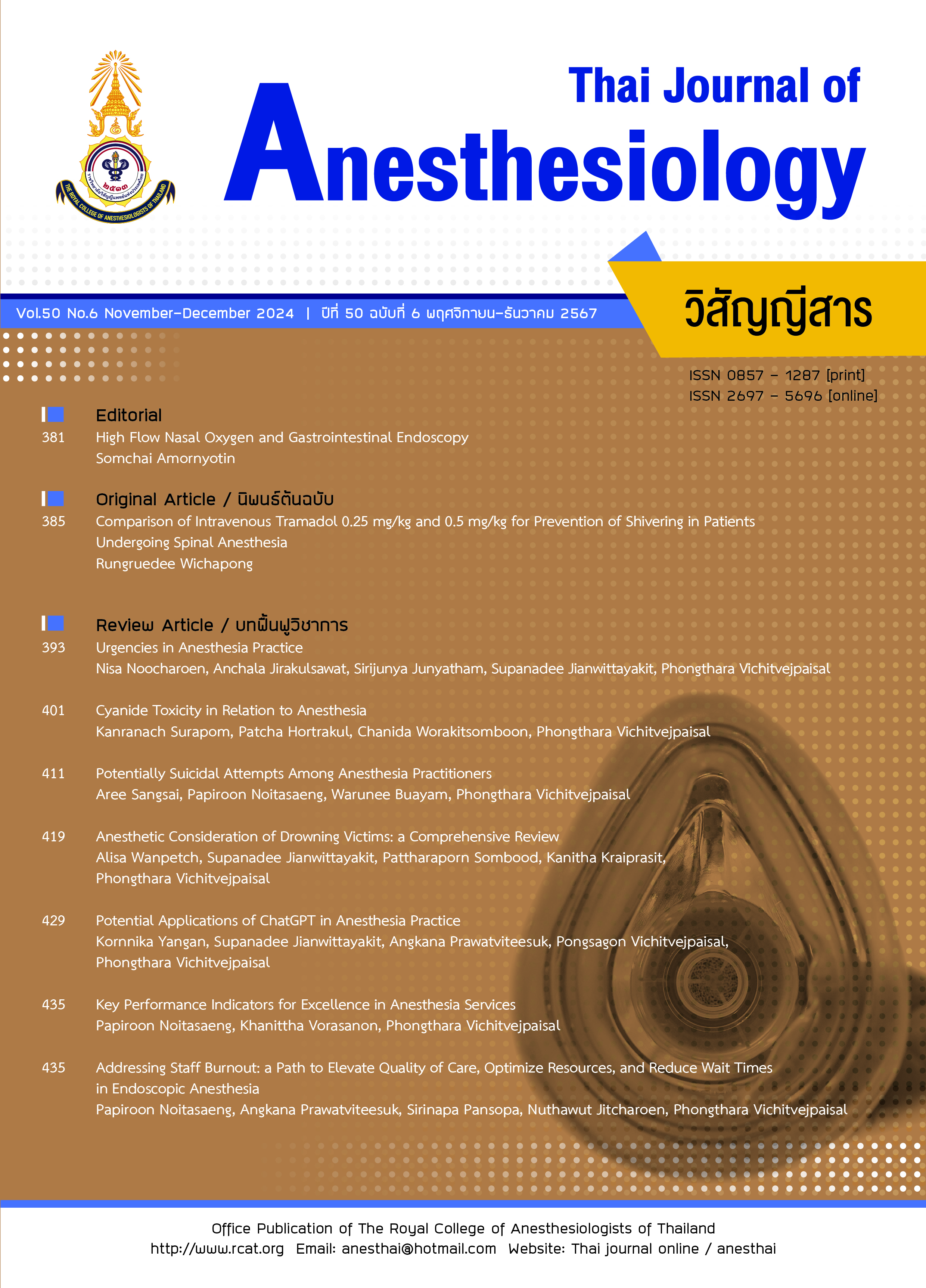การเปรียบเทียบยา tramadol ขนาด 0.25 มก/กก และ 0.5 มก/กก ทางหลอดเลือดดำเพื่อป้องกันภาวะหนาวสั่นในผู้ป่วยที่เข้ารับการผ่าตัดภายใต้การใช้ยาชาเฉพาะที่เข้าช่องน้ำไขสันหลัง
Main Article Content
บทคัดย่อ
บทนำ: ยา tramadol 0.5 มก/กก เป็นขนาดยาที่น้อยที่สุดที่ให้ผลดีในการป้องกันการเกิดภาวะหนาวสั่น ยังไม่พบการศึกษาขนาดยา tramadol 0.25 มก/กก เพื่อใช้ป้องกันการเกิดภาวะหนาวสั่น การศึกษานี้เพื่อเปรียบเทียบประสิทธิภาพของยา tramadol ขนาด 0.25 มก/กก และ 0.5 มก/กก ว่าสามารถป้องกันการเกิดภาวะหนาวสั่นจากการฉีดยาชาเฉพาะที่่เข้าช่องน้ำไขสันหลังได้หรือไม่ วิธีการศึกษา: การศึกษาแบบสุ่มชนิดไปข้างหน้าอำพรางสองฝ่าย ผู้เข้าร่วมการศึกษาเป็นผู้ป่วยที่มารับการผ่าตัดภายใต้การใช้ยาชาเฉพาะที่เข้าช่องน้ำไขสันหลังแบบนัดหมายล่วงหน้าโรงพยาบาลมหาสารคามจำนวน 86 ราย สุ่มผู้ป่วยออกเป็น 2 กลุ่ม กลุ่มที่ 1ได้รับยา tramadol 0.25 มก/กก และกลุ่มที่ 2 ได้รับยา tramadol 0.5 มก/กก หลังผู้ป่วยได้รับยา heavy bupivacaine เข้าช่องน้ำไขสันหลังได้มีการวัดอุณหภูมิกาย ความดันเลือด และระดับภาวะหนาวสั่นโดยใช้การจำแนกระดับภาวะหนาวสั่นของ Crossley และ Mahajan ผลการศึกษา: ประสิทธิภาพในการป้องกันการเกิดภาวะหนาวสั่น กลุ่มที่ 1 ร้อยละ 81.4 กลุ่มที่ 2 ร้อยละ 86.0 (P=0.559) โดยเกิดภาวะหนาวสั่นระดับ 3 ขึ้นไปร้อยละ 18.6 ในกลุ่มที่ 1 และร้อยละ 14.0 ในกลุ่มที่ 2 (P=0.502) และผลข้างเคียงจากยาทั้ง 2 กลุ่มไม่แตกต่างกัน สรุป: ยา tramadol ขนาด 0.25 มก/กก สามารถป้องกันการเกิดภาวะหนาวสั่นจากการให้ยาชาเฉพาะที่เข้าช่องน้ำไขสันหลังได้ไม่แตกต่างจากขนาด 0.5 มก/กก และ ผลข้างเคียงจากยาทั้ง 2 กลุ่มไม่แตกต่างกัน
Article Details

อนุญาตภายใต้เงื่อนไข Creative Commons Attribution-NonCommercial-NoDerivatives 4.0 International License.
เอกสารอ้างอิง
Ozaki M, Kurz A, Sessler DI, et al. Thermoregulatory thresholds during epidural and spinal anesthesia. Anesthesiology. 1994;81:282-8.
Jeon YT, Jeon YS, Kim YC, Bahk JH, Do SH, Lim YJ. Intrathecal clonidine does not reduce post-spinal shivering. Acta Anaesthesiol Scand. 2005;49:1509-13.
Chow TC, Cho PH. The influence of small dose intrathecal fentanyl on shivering during transurethral resection of prostate under spinal anesthesia. Acta Anaesthesiol Sin. 1994;32:165-70.
Imrie MM, Hall GM. Body temperature and anaesthesia. Br J Anaesth. 1990;64:346-54.
Girma T, Alemu W, Assen S. Effect of prophylactic intrathecal pethidine on the incidence of shivering on mothers undergoing cesarean section under spinal anesthesia: a randomized controlled trial. Front Med. 2022;9:887724.
de Witte J, Deloof T, de Veylder J, Housmans PR. Tramadol in the treatment of postanesthetic shivering. Acta Anaesthesiol Scand. 1997;41:506-10.
Driessen B, Reimann W. Interaction of the central analgesic, tramadol, with the uptake and release of 5-hydroxytryptamine in the rat brain in vitro. Br J Pharmacol. 1992;105:147-51.
Driessen B, Reimann W, Giertz H. Effects of the central analgesic tramadol on the uptake and release of noradrenaline and dopamine in vitro. Br J Pharmacol. 1993;108:806-11.
Crossley AW, Mahajan RP. The intensity of postoperative shivering is unrelated to axillary temperature. Anaesthesia. 1994;49:205-7.
Mohta M, Kumari N, Tyagi A, Sethi AK, Agarwal D, Singh M. Tramadol for prevention of postanaesthetic shivering: a randomised double-blind comparison with pethidine. Anaesthesia. 2009;64:141-6.
Nazir A, Dar FA, Javed T. A comparative study; Prophylactic intravenous ketamine and tramadol in preventing intraoperative shivering in patients undergoing elective lower limb surgery under spinal anaesthesia. Am J Adv Drug Deliv. 2015;3:011-7.
Javaherforoosh F, Akhondzadeh R, Aein KB, Olapour A, Samimi M. Effects of tramadol on shivering post spinal anesthesia in elective cesarean section. Pak J Med Sci. 2009;25:12-7.
Onyekwulu FA, Agu EE, Amucheazi AO. Efficacy of intravenous tramadol in the control of shivering following spinal anaesthesia for caesarean section. Niger Postgrad Med J. 2016;23:116-20.
Wason R, Jain N, Gupta P, Gogia AR. Randomized double-blind comparison of prophylactic ketamine, clonidine and tramadol for the control of shivering under neuraxial anaesthesia. Indian J Anaesth. 2012;56:370-5.
Ularangkura W, Chokchalermwong N, Sukonpatip T. Efficacy of intravenous paracetamol for prevention of shivering in cesarean section under spinal anesthesia: a randomized controlled trial. Thai J Anesthesiol. 2023;49:311-8.
Lema GF, Gebremedhn EG, Gebregzi AH, Desta YT, Kassa AA. Efficacy of intravenous tramadol and low-dose ketamine in the prevention of post-spinal anesthesia shivering following cesarean section: a double-blinded, randomized control trial. Int J Women’s Health. 2017;9:681-8.
Lakhe G, Adhikari KM, Khatri K, Maharjan A, Bajracharya A, Khanal H. Prevention of shivering during spinal anesthesia: comparison between tramadol, ketamine and ondansetron. JNMA J Nepal Med Assoc. 2017;56:395-400.
Cahyadi R, Nasution AH, Lubis A. Comparison of intravenous ketamine 0.25 mg/kgBW and intravenous tramadol 0.5 mg/kgBW for prevention of shivering post spinal anesthesia. Int J Innov Sci Res Technol. 2019;4:262-70.
Seyam SH. Prevention of post-spinal anesthesia shivering: low dose ketamine vs tramadol. Al-Azhar Int Med J. 2020;1:108-15.
ธิดารัตน์ อริยานุชิตกุล, ศักดิ์กฤษณ์ ประสิทธิ์ศุภการ. ปัจจัยที่มีผลต่อการเกิดอาการหนาวสั่นระหว่างผ่าตัดในผู้ป่วยผ่าตัดกระดูกที่ได้รับการฉีดยาชาเข้าช่องไขสันหลัง. วิสัญญีสาร. 2563;46:234-9.
Ameta N, Jacob M, Hasnain S, Ramesh G. Comparison of prophylactic use of ketamine, tramadol, and dexmedetomidine for prevention of shivering after spinal anesthesia. J Anaesthesiol Clin Pharmacol. 2018;34:352-6.
Gangopadhyay S, Gupta K, Acharjee S, Nayak S K, Dawn S, Piplai G. Ketamine, tramadol and pethidine in prophylaxis of shivering during spinal anaesthesia. J Anaesthesiol Clin Pharmacol. 2010;26:59-63.


